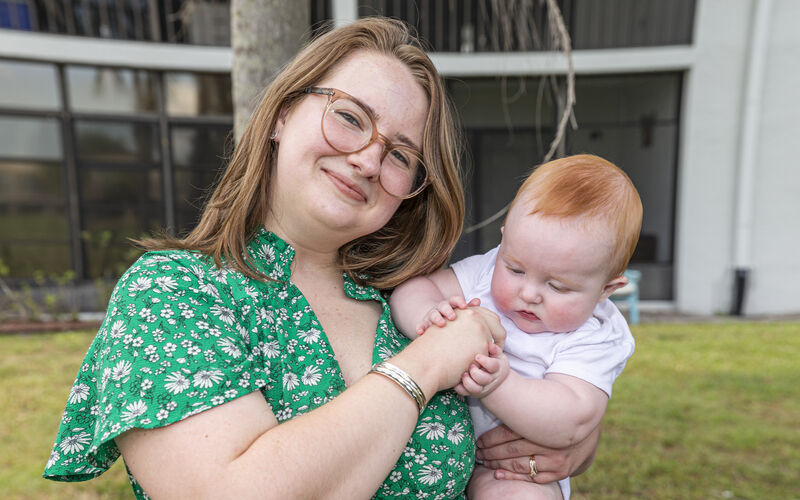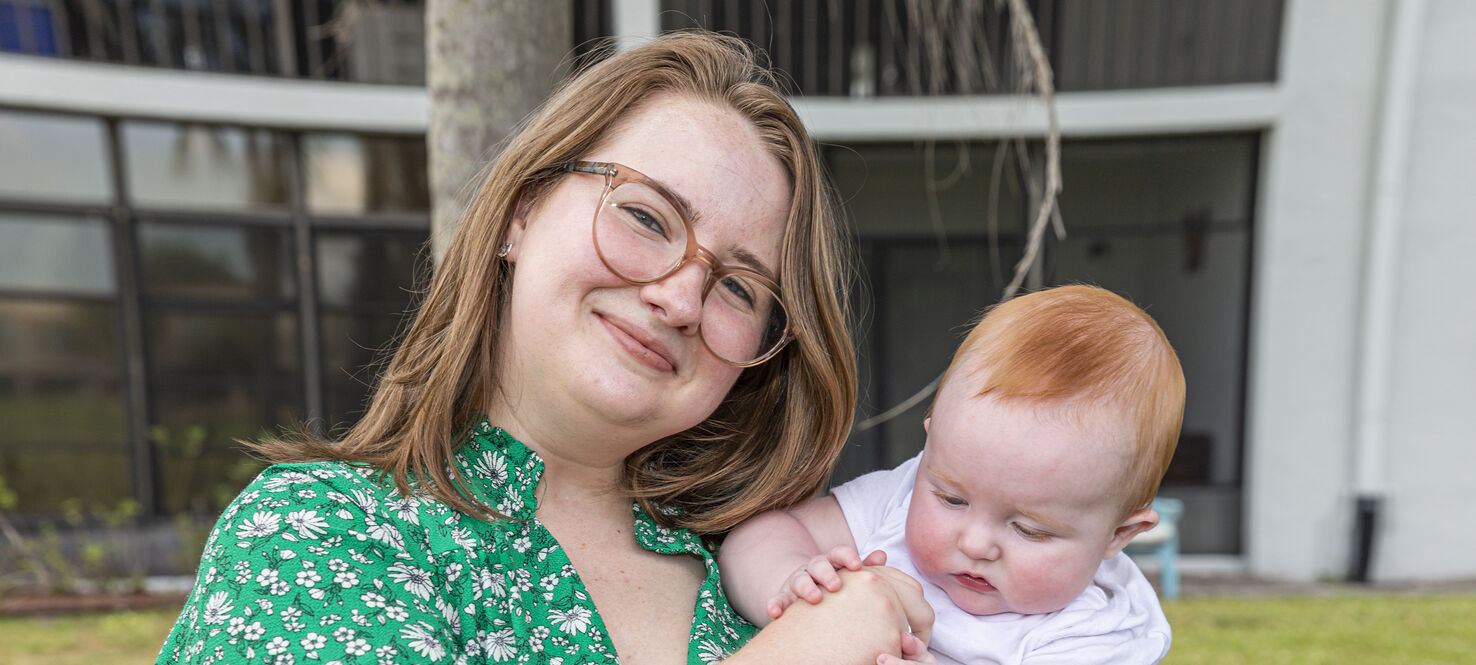Experimental Vaccine Gives Young Mother a Shot at Cure
As Dallas Carroll held her newborn son, Dakota, in her arms, she pictured her future. A happy, full house with her older son, 3-year-old Finnry, showing Dakota the ropes, and teen stepdaughter Riley smothering him with kisses. Family vacations, graduations and holiday celebrations.
That dream of the life ahead was shattered just one week later, in December 2023, when Dallas was diagnosed with stage 4 metastatic breast cancer. She was 29.
“I didn’t understand the full extent of what was going on. I felt like a pinata, just constantly taking blows,” Dallas said. “I had a lot of hormones raging and didn’t know how to process them. I felt really hopeless.”
Above all, she felt angry. During her pregnancy, she noticed a lump on her breast and a few other breast changes. She told her obstetrics team where she lived in Alabama but says her symptoms were dismissed as typical hormonal changes during pregnancy.
Dallas was never satisfied with that answer and continued to bring up her concerns. Finally, in the last few weeks of her pregnancy, she was referred for a mammogram and ultrasound. However, she delivered Dakota early and couldn’t complete the screening tests that revealed her cancer until a week after he was born.
“I just kept pushing and pushing. I was fine looking like a hypochondriac,” Dallas said. “I knew something was wrong.”
Further testing revealed the cancer had spread to Dallas’ bones and liver. She was set up to start chemotherapy at a local hospital when her sister, who lives in Florida, suggested she get a second opinion at Moffitt Cancer Center. Dallas first refused because she wanted to start treatment close to home as soon as possible, but she eventually gave in to her sister’s and husband’s urging and flew to Tampa for a consultation.
At the appointment, breast oncologist Aixa Soyano, MD, told her that if she underwent standard treatment, her prognosis was likely five to seven years.
“That was the first time someone had told me that,” Dallas said. “That wasn’t going to work for me. I need a long life.”
There was a second option: an experimental vaccine that involved a special type of immune cell taken from her blood.

Aixa Soyano, MD
“I had an extensive discussion with Dallas about the treatment options in order to personalize her journey based on her situation,” Soyano said. “Adding this experimental treatment to her journey gave her the opportunity to defy the odds.”
Soyano didn’t know how long it would take to get the experimental treatment approved for Dallas or if she would even respond well to the vaccine. But Dallas knew it was her best chance to see her kids grow up.
“I was willing to risk it. To me, the risk outweighed everything.”
Targeted Delivery
Dendritic cells are a special type of immune cell that boosts immune responses by highlighting foreign cells for the immune system to attack. They can be harvested from a patient and used to create a personalized vaccine.
Initial trials investigated the use of a dendritic cell vaccine in early stage breast cancer. While the vaccine showed some success in the earliest form of breast cancer called ductal carcinoma in situ, it didn’t seem to work in invasive breast cancers. The trials did show, however, that if the vaccine helped get rid of a patient’s disease, it was unlikely their breast cancer would ever return.
Recognizing the potential of the treatment, researchers switched to injecting dendritic cells directly into a tumor rather than intravenous injection. In the lab, when the cells were injected directly into a mouse’s tumor, the tumor would disappear. Researchers also discovered new agents they could combine with the dendritic cells to make the treatment even more effective.
“If we put two tumors on different spots of the mouse and only treated one of them, we could make the other tumor that was metastatic go away at the same time. So, it was suggested that we could potentially influence the whole immune response everywhere,” said Brian Czerniecki, MD, PhD, chair of Moffitt’s Breast Oncology Department.

In human trials, the vaccine injected directly into the primary tumor showed promise in earlier stage breast cancers prior to chemotherapy. But what about for patients who present with stage 4 disease?
Patients with advanced-stage HER2-positive breast cancer usually get bounced around from treatment to treatment for a few years until the disease eventually becomes resistant to all therapies. The dendritic cell vaccine was designed to give those patients a better option.
“The idea is to cure these patients instead of turning it into chronic disease,” Czerniecki said.
A Vast Improvement
So far at Moffitt, two young women with stage 4 HER2- positive breast cancer have been treated with the experimental vaccine. Dallas is the second.
The process started with Dallas undergoing apheresis, a blood collection separation procedure that takes white blood cells out and returns red blood cells and plasma to the body. The extracted white blood cells are taken to the lab, where a bacterial agent and a protein called gamma interferon are added to the dendritic cells to help activate an immune response. It’s then pulsed with HER2-positive proteins to help the immune system better recognize Dallas’ cancer.
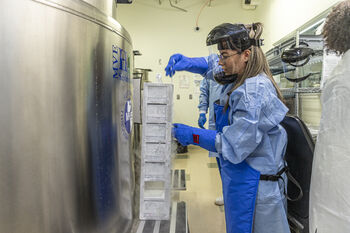
Dendritic cells, which boost immune responses, can be harvested from a patient and used to create a personalized vaccine. In the lab, the harvested cells are boosted into the billions. They are then separated into doses of about 100 to 200 million cells that can be frozen and preserved. The doses are thawed a few hours before the patient receives the injection.
At the end of the manufacturing process, Dallas had about 2 billion dendritic cells ready to attack her cancer. They are separated into doses of about 100 to 200 million cells that can be frozen and preserved for up to 11 months. Each dose is thawed a few hours prior to injection.
Dallas received her first dose of the vaccine in January 2024. Once a week for six weeks, she came to Moffitt where Czerniecki or a member of his team injected the cells directly into her breast tumor under ultrasound guidance. Halfway through the treatment, Dallas and her family relocated to Punta Gorda, Florida, to be closer to Moffitt and her sister.
After six doses, Dallas’ breast tumor shrank from 80 millimeters to 11 millimeters. Some of the spots on her bones showed healing, and the lesions on her liver also shrank. Since she responded so well and she still had cells left, Dallas began a second round of eight vaccinations in May 2024.
Scans after the second round of vaccines showed continued decrease in disease and a spot on Dallas’ spine fully resolved. At the end of June, she began chemotherapy with the hope that her previous immune response will make treatment more effective.
As part of the standard treatment for advanced HER2-positive breast cancer, Dallas also gets injections every three weeks of a fixed-dose immunotherapy combination medication called Phesgo, which targets the HER2 protein in her breast cancer cells. It is injected intravenously into her leg.
She experiences common immunotherapy side effects for a few days after treatment — fevers, chills and body aches — but most days Dallas is a normal mom. She no longer feels she is living under the weight of her initial prognosis of only a few years.
“I am still here living my best life. There is no time for me to just lay here. There is no time to feel bad,” Dallas said.
A Future First-Line Treatment
In addition to the success of the vaccine in the two advanced-stage patients, a trial using it in combination with lower dose chemotherapy in earlier stage HER2-positive breast cancer patients has promising results. Multiple patients on that trial have achieved a complete response, so the odds of being cured are extremely high.
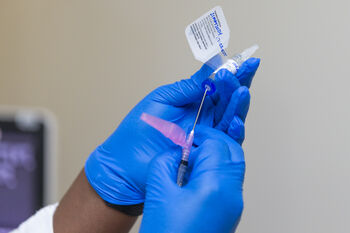
After the vaccine is thawed, it is administered directly into the tumor via ultrasound guidance.
Czerniecki’s lab is also investigating ways to make the dendritic vaccine for HER2-positive patients even more effective. He is hoping to open a new human trial using cells that have been pulsed with an additional innate lipid that should help further increase immune response.
“I think ideally the vaccine should be the first thing that someone should have done before other treatment,” Czerniecki said. “Then you can do chemotherapy, surgery or radiation because once you rev the immune system right, it will make all those things work better.”
The vaccine could also be used for what Czerniecki calls “immuno-surgery.” If a surgeon cannot get clear margins or remove all of a tumor, the cells could be injected directly into those areas in the operating room, or a catheter could be inserted to deliver the cells to the affected area after surgery.
Moffitt is investigating the use of a dendritic cell vaccine in patients with leptomeningeal disease, a rare complication that occurs when cancer cells spread from the original tumor site to the meninges, the protective membranes that surround the brain and spinal cord. It occurs in about 5% of breast cancer patients and has a dismal prognosis, with many patients dying within two to four months.
Patients on the phase 1 trial, who have HER2-positive or triple-negative breast cancer, receive injections directly into their spinal fluid once a week for 12 weeks. A few patients are demonstrating prolonged survival well past the average prognosis.
A dendritic cell vaccine has also proved to be safe and effective if administered before and after an autologous stem-cell transplant for patients with high-risk multiple myeloma. Phase 1 trial results published in 2023 show 85% of the 13 patients on the trial demonstrated an immune response.
Next up is working on a vaccine for triple-negative and estrogen-receptor-positive breast cancers, but the vaccines could ultimately be tailored for multiple cancer types.
“We can design almost anything for any kind of tumor because a lot of tumors have mutations, and we can target any mutations in a tumor,” Czerniecki said. That could include tumors that are easily accessible such as prostate, liver, brain and skin cancers.
The vaccine could also be a valuable tool for treating older patients who have other comorbidities and cannot tolerate aggressive chemotherapy regimens. More trials are needed, but the treatment has the potential to become an FDA-approved therapy with multiple applications.
An Appreciation for Ordinary Moments
On a hot summer day, Dallas Carroll tries to get her family out the door. Finnry is playing with a new dark red sports car, and Dakota is bouncing in his baby chair, waiting for Riley to pick him up.
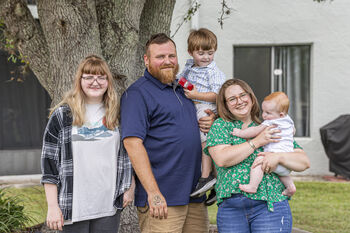
Less than a year after her diagnosis, Dallas treasures every moment with her family: husband Jeremy, stepdaughter Riley, 3-year-old Finnry and her newest handful, Dakota. She continues to get injections of an immunotherapy combination medication.
When they get outside, Finnry throws his car and stomps his feet in a puddle. He giggles and looks up at his mom with his big blue eyes. They’ve only just locked the front door when Dallas’ husband realizes Dakota needs a diaper change.
It’s a moment that would make most moms sigh in frustration, but it’s one Dallas does not take for granted. She is hoping for many more frustrating parenthood moments, along with the lifetime of moments she envisioned when Dakota was born.
“No one has told me I would only live five to seven years again, and if they did, I would say, ‘OK, we will see.’ That is not my wishful thinking or trying to be positive, that is what I truly think.”
This article originally appeared in Moffitt's Momentum magazine.


